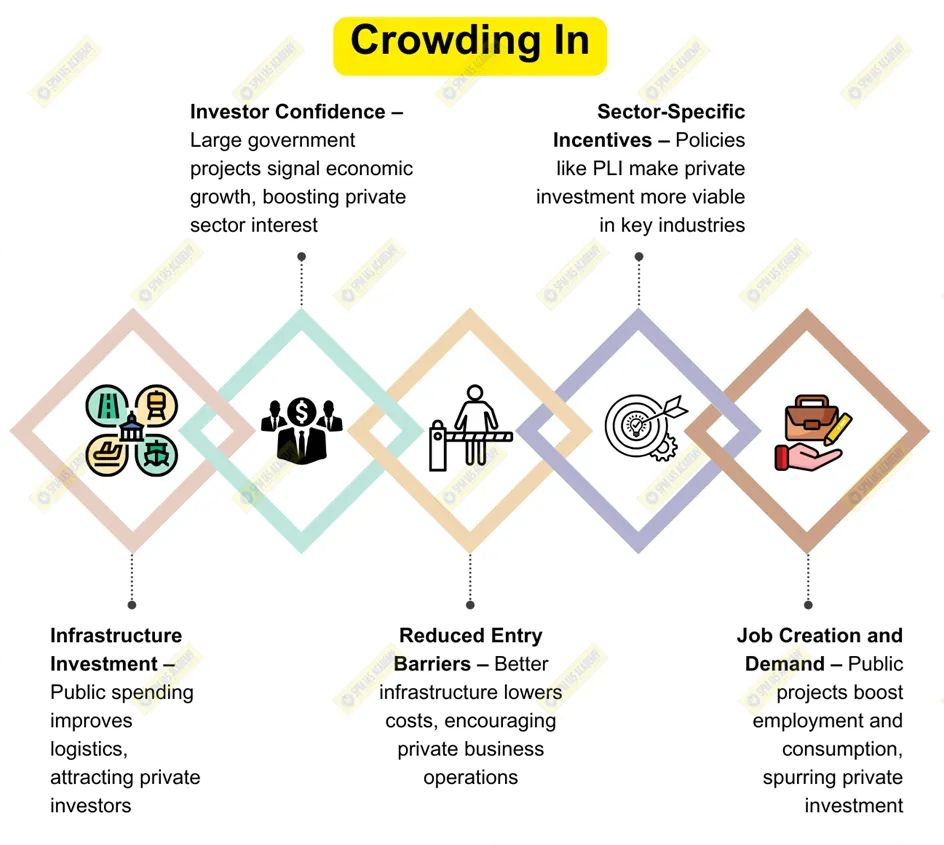The Union Budget 2023-24 emphasizes the ‘crowding-in effect’ as a key strategy for stimulating economic growth. This approach involves boosting public sector investment in infrastructure and development to attract private sector investment, thereby fostering an overall environment of economic expansion. Here’s how the budget relies on this effect, along with supporting data and insights:

A. Record Public Investment to Spur Private Sector Growth
- The budget has allocated a record ₹10 lakh crore for capital expenditure, representing 3.3% of GDP, and marking a 33% increase from the previous year. This significant outlay in sectors like transport, energy, and digital infrastructure is designed to “crowd in” private investment, as the government seeks to address critical infrastructure gaps that would otherwise deter private participation.
- Raghuram Rajan, former RBI governor, emphasized that strategic public investment can generate a multiplier effect, encouraging private players to invest by reducing operational costs and improving logistical efficiency.
B. Infrastructure Push with ‘Gati Shakti’ and ‘PM Gati Shakti National Master Plan’
- The budget continues to support the PM Gati Shakti National Master Plan, which coordinates multiple infrastructure projects across sectors, optimizing resources and timelines. With this coordinated infrastructure boost, the government aims to improve connectivity and reduce bottlenecks, which will lower operational costs and attract private investments in logistics and manufacturing.
- Economist Arvind Panagariya notes that an integrated infrastructure approach helps improve the investment climate, as private companies benefit from reduced delays and increased efficiency.
C. Incentives for Green Growth and Energy Transition
- The government has allocated ₹35,000 crore towards achieving net-zero goals and green growth initiatives, focusing on energy transition, renewable energy, and green hydrogen. This investment provides a platform for private companies to enter emerging green sectors, enhancing India’s global competitiveness in sustainable industries.
- According to NITI Aayog, incentivizing green energy can attract private investment in renewables and associated technologies, accelerating India’s shift to a sustainable energy economy while reducing reliance on fossil fuels.
D. Production-Linked Incentive (PLI) Schemes
- The government extended its PLI schemes to additional sectors with a cumulative budgetary commitment of over ₹2 lakh crore, targeting manufacturing sectors like electronics, pharmaceuticals, and automotive. These incentives aim to reduce production costs for private players, thereby “crowding in” investments and promoting India as a manufacturing hub.
- Bibek Debroy, Chairman of the Economic Advisory Council, has highlighted that PLIs offer an opportunity for private firms to scale up and compete globally, making India more attractive to investors.
E. Boosting the Financial Sector for Easy Access to Credit
- The budget emphasizes enhancing the capacity of public sector banks (PSBs) and regional rural banks (RRBs) to improve credit access, particularly for MSMEs and startups. By strengthening financial institutions, the government aims to reduce financing constraints, encouraging private players to borrow and invest in expansion projects.
- C Rangarajan, former RBI governor, commented that increased credit flow is essential for crowding in private sector investment, particularly in high-growth potential sectors like MSMEs, which play a critical role in employment and economic output.
The Union Budget 2023-24 strategically leverages the crowding-in effect by increasing public investments in infrastructure, green energy, and manufacturing to stimulate private sector participation. This aims to drive long-term economic growth, job creation, and productivity, aligning with India’s goal of becoming a $5 trillion economy through a self-sustaining, investment-driven growth model.











